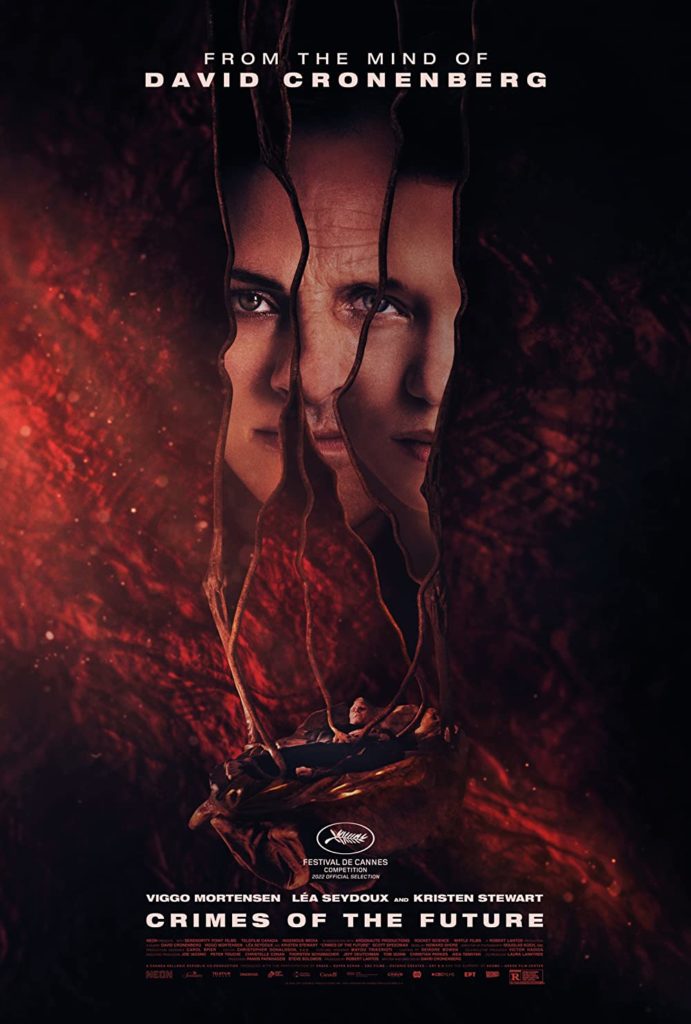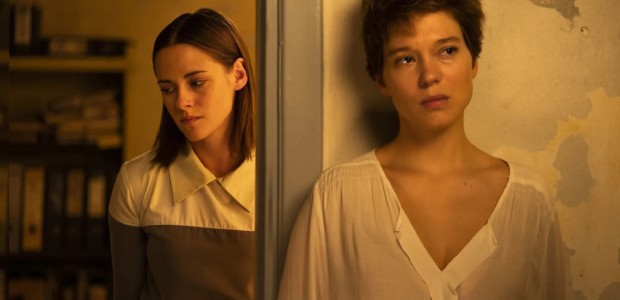
![]()
The Anatomy Lesson
In an unspecified future, human beings have progressed enough with body modifications and other biological experimentation that pain has virtually been erased. Surgery is readily available and even safe to undergo in the privacy of one’s own home…no matter how involved the procedure.
This state-of-affairs has led to a rise in performance artists, those whose bodies are the canvas undergoing experimentation and alteration for the benefit of their audiences. New organs are grown, appendages grafted on, skin and tissue sliced, and more to the delight of captivated audiences recording the whole affair on their antiquated cameras.
The undisputed king of this new class of artists is Saul Tenser (Viggo Mortensen) who works with his partner/lover/former trauma surgeon Caprice (Léa Seydoux) on new shows that involve him growing new organs and then excising them. This is all done under the auspices of the National Organ Registry, a governmental body that doesn’t legally exist but still has pull with authorities. It’s overseen by the enthusiastic Wippet (Don McKellar) and the conscientious Timlin (Kristen Stewart).
But there are shadowy figures moving in this new world and using its weird technology. An officer (Welet Bungué) of the New Vice Unit is watching for these people attempting to branch off the evolutionary path while a growing conspiracy of modified humans seems to be gaining traction, all while Saul and Caprice try to identify this new landscape and navigate its many cavities and groupings.

The Portrait Of The Artist As An Old Man
Writer/director David Cronenberg is 79 years old and has been making films for over 50 of those (his second feature? CRIMES OF THE FUTURE in 1970). His career has gone from art films to TV documentaries, to TV movies, to pulp horror, to prestige drama, literary adaptations, historical character sketches, while moving from the grindhouse to the arthouse, racking up accolades alongside his ostensible role as the pope of body horror. The Canadian auteur is synonymous with the subgenre focused on the mutilation, mutation, perversities, and possibilities of biology human and inhuman. Despite that seemingly inextricable link, Cronenberg hasn’t made a movie that could definitively be identified by his trademark fascination with the biomechanical and anatomically transformed since 1999’s EXISTENZ.
Had he grown sick of the little macabre enclave in which he had played? Said all he wanted to say about it? Did the poor reception of EXISTENZ sour the gross taste in his mouth? Was he tired of wading through the buckets of K-Y Jelly and piles of silicone prosthetics, choosing instead the more respectable world of the dramatic or the thriller? Sure, his horror films were critically acclaimed and part of the Criterion collection and even profitable…but maybe these transgressive delights were more suited for younger artists, those like David’s own son Brandon who has had recent body horror hits of his own with ANTIVIRAL and POSSESSOR.
That’s a lot of questions and background but it’s important because Cronenberg brings all of that to CRIMES OF THE FUTURE. Saul (as opposed to…David) is an aging artist who is a giant in the scene but constantly has other performers competing for that spotlight. He is renowned for his shocking artistry that is beautiful in its crystalline grotesquery but is racked with doubt about each project and uncertain what will be next.
He is an innovator, but is there a lot more to say still? Does this world of experimental surgery and transforming anatomies still have a place for him and his ways? Is his lover and frequent collaborator still interested in him or is she breaking away? Despite all the insectoid biomechanical instrumentation, and the deep lacerations, and body modifications, and sinister machinations, this movie is a reflection of a 79-year-old artist pondering his place in life, in the medium he loves, in the subgenre he helped foster, and the world at large. And it is an abundantly gorgeous look at that.
Not necessarily in the traditional aesthetic view, but in terms of its dingy, broken-down world. The stained stone of a Greek seaside town that seems to exist out of time and yet in all times too. The tools and technology involved in the film are almost quintessential Cronenberg designs that blend the harsh ergonomic approaches of brutalism, the arthropodic sleekness of biomechanical, and the feeling of extensions of the human users themselves as if they are connected by sinew and neural pathways (which, in some cases, they are). If that sounds familiar, it should because a lot of CRIMES OF THE FUTURE is familiar, but never feels like a greatest hits or dipping back into the body horror well.
There is the similarly operated bits of organic tech that recall VIDEODROME and EXISTENZ; the growing of new organs like RABID; the meditation on children and parenthood echoing THE BROOD; SCANNERS’ various factions facing off in ways political and horrific; the mystery and distrust of THE DEAD ZONE; the sensuality, romance, and intrigue between lovers of CRASH and M. BUTTERFLY; the outsider artist as transgressive spy of NAKED LUNCH; like THE FLY and SCANNERS and more, it seeks to foresee the next phase of human evolution. And it’s not just themes, there are direct visual representations of each of these elements and previous works woven quietly, seamlessly into CRIMES OF THE FUTURE. And it’s not just body horror as the double life of A HISTORY OF VIOLENCE and EASTERN PROMISES is an important part. The cinematography by Douglas Koch is warmer and closer than Cronenberg’s early (often emotionally detached) movies, which better resembles works like COSMOPOLIS and A DANGEROUS METHOD. And on and on.
Perhaps it’s not intentional, however unlikely that may be. But if it isn’t then it shows how much Cronenberg’s ponderings about his life, legacy, and current purpose in the world has seeped into his art and dragged along his entire work with it. What does he have to say? What has he ever said? Who is listening?

Mettre Au Monde
Coming out of the movie, my friend and I had what seemed like totally differing views on what CRIMES OF THE FUTURE is really about. We both loved it. The incredible performances by Seydoux and Mortensen (and, curveball, Scott Speedman). The exquisite production design. The creepy unsettling atmosphere easily cultivated. The beautifully disgusting set pieces. The lush Howard Shore score. The unexpected bursts of comedy. We were agreed on all of that…but what was the story behind the story?
I held that it was about being an artist, an aging artist specifically. That’s why there are so many allusions to Cronenberg’s own filmography. The central character is an artist, one who is constantly struggling to speak due to the changes he’s undergoing…losing his voice while competitors (young artists who all seem derivative at best) spring up around him. An artist separated from the pain of youth, of that rage and heartbreak and more that smooths out with age and gained perspective. Is he still vital? Or is he just a name, an institution that carries out work for the fairly reputable suits? “Real” art usually associated with poverty and angst, and yet Saul’s mugwump-looking chairs and beetle-appearing sarcophagi are expensive and lovely, and he constantly seeks to be comfortable. Which path does he wish to take?
My friend, on the other hand, believed CRIMES OF THE FUTURE is about parenthood. It’s about growing something and choosing whether to reject or accept it. That the future is unknown and yet shaped by the adults of the present. A storyline involving a particularly nasty family is a major plot point in CRIMES OF THE FUTURE, so that echoes such a push and pull between love and revulsion that can be found in every family. The abject grossness of childbirth mashed up with the miracle of life. The horrors of dealing with a child’s wild emotions and the joys of purpose that they bring. These offshoots of us are the source of happiness and misery and fear and hope and the people in Cronenberg’s film are navigating all of those feelings amidst a world that seems broken down in a decadent future.
The fact is that we’re both right.
Creation of art and creation of a child aren’t that different when zoomed out enough. Anyone that has attempted to paint, write, sculpt, compose, whatever can talk about the effervescent rush of making something and seeing what is in your head and heart takes shape through you. But it’s also riddled with doubt and self-loathing. You may love it, but the everyone else might think it’s a repugnant mass. New life to one person can just be a tumor to another. Bringing these things from unbeing into being is a leap of faith with no sign of how it will turn out. You can only pray and try your best that what you bring into the world is something Good and something significant. That is has the best of us and that it isn’t relegated to the shadows. Cronenberg’s CRIMES OF THE FUTURE is about making something, even after years of making lots of somethings, and not being sure what it is or how it will turn out…but going into an uncertain future forever curious and prepared to say something about it.
So, as I said, we were both right. Twice over, in fact; not just about our theories as to the movie’s meaning but also about the fact that CRIMES OF THE FUTURE is a genuine masterpiece that slips its slimy fingers into your brain and sloshes your thoughts around, leaving you to contemplate your own place in the messy flow of time.
Tags: Canada, Carol Spier, Christopher Donaldson, David Cronenberg, Denise Capezza, Dimitra Sourlantzi, Don McKellar, Douglas Koch, Greece, Horror, Howard Shore, Kristen Stewart, Lea Seydoux, Lihi Kornowski, Nadia Litz, neon, Scott Speedman, Tanaya Beatty, Viggo Mortensen, Welet Bungué



No Comments